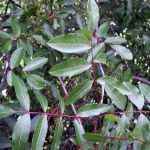| Common Name: |
Cyprus Turpentine |
| Other Names: |
Terebinth Tree |
| Botanical Name: |
Pistacia terebinthus |
| Genus: |
Pistacia |
| Family: |
Anacardiaceae |
| Native Location: |
Mediterranean |
| Cultivation: |
Well-drained to dry, sandy or stony, alkaline soil in sun. Trim plants in spring to restrict size. |
| Propagation: |
By seed sown at 25°C (77°F) in early spring; by greenwood cuttings in late spring or early summer; by semi-ripe cuttings in summer. |
| Harvest: |
Resin is obtained from incisions in bark from mid-summer to mid-autumn, and dried for powder (P. lentiscus) or distilled for oil and essence (P. lentiscus, P. terebinthus). Seeds are pressed for oil when ripe. |
| Height: |
6m (20ft) |
| Width: |
2-6m (6-20ft) |
| Hardiness: |
Z9 |
| Parts Used: |
Resin, essence |
| Properties: |
A bitter, aromatic, antiseptic herb that is expectorant, relaxes spasms, controls bleeding, promotes healing, and is effective against various parasitic organisms. |
| Medicinal Uses: |
Internally for chronic bronchial infections, streptococcal, urinary, and renal infections, hemorrhage, gallstones, tapeworm, and rheumatism. Externally for arthritis, gout, sciatica, scabies and lice. |
| Culinary Uses: |
Seeds and seed oil are edible. Resin is chewed as chewing gum. Immature fruits clusters are picked as a condiment. |
| Bibliography: |
Encyclopedia of Herbs by Deni Brown Copyright © 1995, 2001 Dorling Kindersley Limited pp.321-322 |

